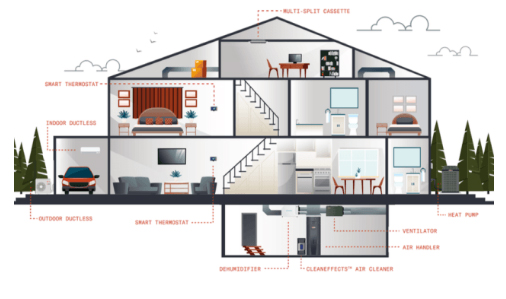How does central cooling work?
In a nutshell, a central HVAC system heats or cools your home by feeding heated or cooled air through your ductwork. While the process seems simple, getting your home to the perfect temperature requires a lot of moving parts with a lot of different components at play.
Understanding the central heating and cooling processes will help you better maintain your HVAC system. Once you know the basics, you’ll know exactly what’s going on in your home the next time you hear your HVAC device kick on.
Central Heating Process
 Central cooling kicks off when a thermostat senses that the temperature in your home needs to be changed. In the case of central cooling, the thermostat will alert your cooling unit that the temperature needs to drop, and all parts will work simultaneously to get your home to your desired temperature
Central cooling kicks off when a thermostat senses that the temperature in your home needs to be changed. In the case of central cooling, the thermostat will alert your cooling unit that the temperature needs to drop, and all parts will work simultaneously to get your home to your desired temperature
Once the systems are alerted, they take these steps to cool your home:
- A fan from the indoor portion of your AC moves room temperature hot air out of your home.
- This air is filtered, so dust, lint and debris are taken out.
- The filtered, hot air is blown over the evaporator coil, a portion of your air conditioner that gets filled with liquid refrigerant. The evaporator coil absorbs the heat from the air, which turns the refrigerant into a gas.
- The newly cooled air is pumped back into your home via ducts.
- While that cool air is being put into your home, the heat that was recently absorbed needs a place to go, too. So, the heated, gaseous refrigerant passes through a copper tube into the outdoor portion of your air conditioner.
- The refrigerant is put into the compressor, which pressurizes the gas and sends it to the condenser coil.
- The condenser coil releases the heat that used to be in your home from the refrigerant, turning it back into a liquid.
- The process starts again.
Central Heating Process
 All central heating processes start the same way central cooling processes do: a thermostat registers the temperature and kicks off the HVAC system.
All central heating processes start the same way central cooling processes do: a thermostat registers the temperature and kicks off the HVAC system.
Heat pumps have the same parts as a split-system air conditioner and work in the same way when they’re needed for cooling. When the temperature drops and a heat pump needs to provide heat, the process essentially reverses itself. Once a heat pump registers the function shift, a reversing valve in the outdoor unit kicks on. This allows the heat pump to absorb heat energy from the outside air and transfer it into the home to warm it up, instead of taking heat from the home and putting it outside to cool it down. The reversing valve is never something that the homeowner needs to touch; the heat pump knows to switch functions on its own!
Furnaces, on the other hand, function in a totally different way than other HVAC products. While the thermostat still kicks off the heating process, all furnaces produce heat from either natural gas, electricity, or fuel oil source, like propane. Depending on the type of unit you own, the fuel source could be located in an outdoor unit or underground, but both will be connected to your home via a pipe.
Once your fuel source is connected, the furnace follows these steps to raise the temperature:
- Fuel comes into the furnace through the pipe and lights the furnace burner.
- Cold air from your home is warmed via the fuel within the furnace heat exchanger.
- Exhaust fuel from combustion is piped out of the furnace through a vent.
- A blower fan inside the furnace directs the newly warmed air through the various ducts in your home.
- More cold air is directed from your home into the furnace via the return ducts.
- The process repeats itself until your home is warmed, at which point the fuel switches off and the furnace stops producing heat.
Source: Trane.com

